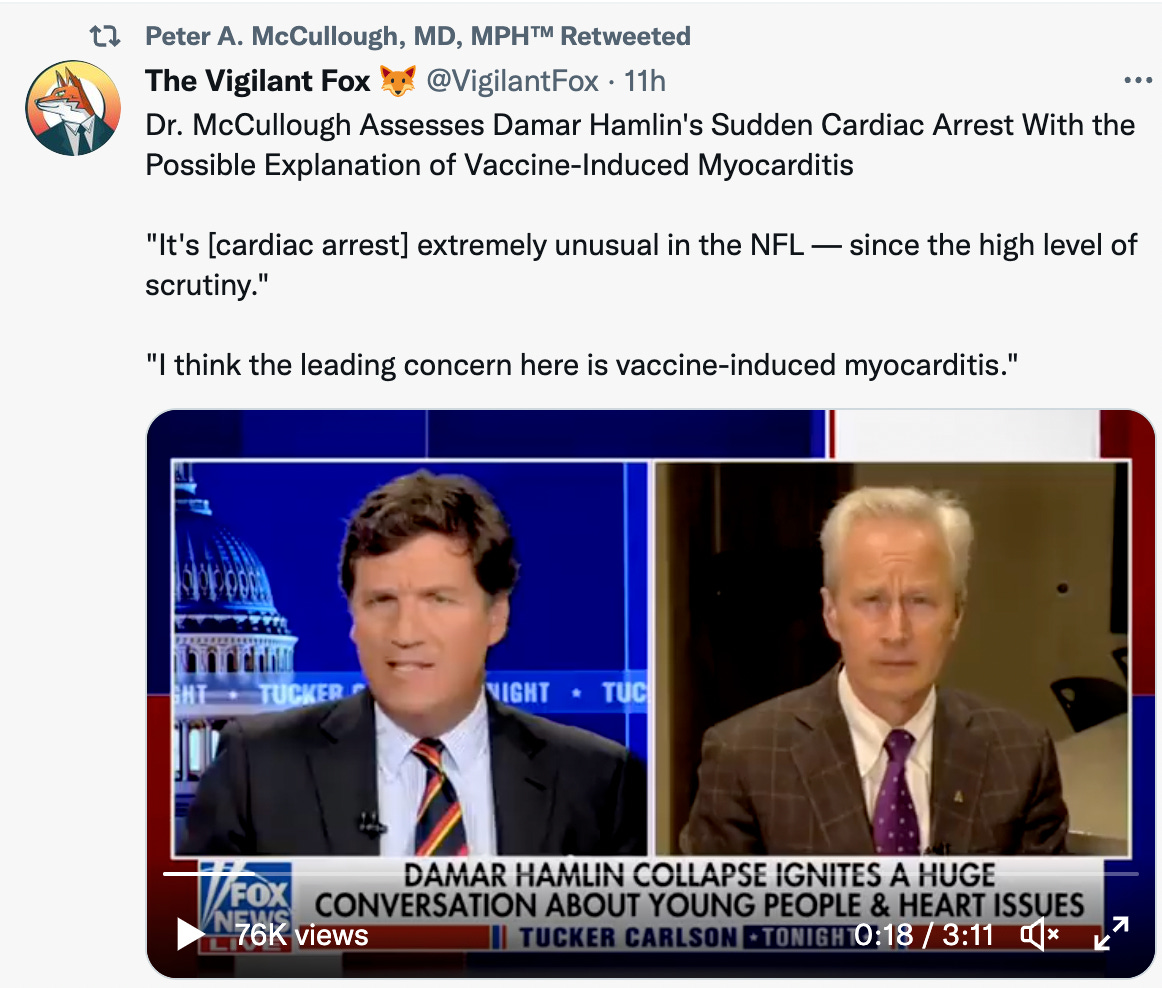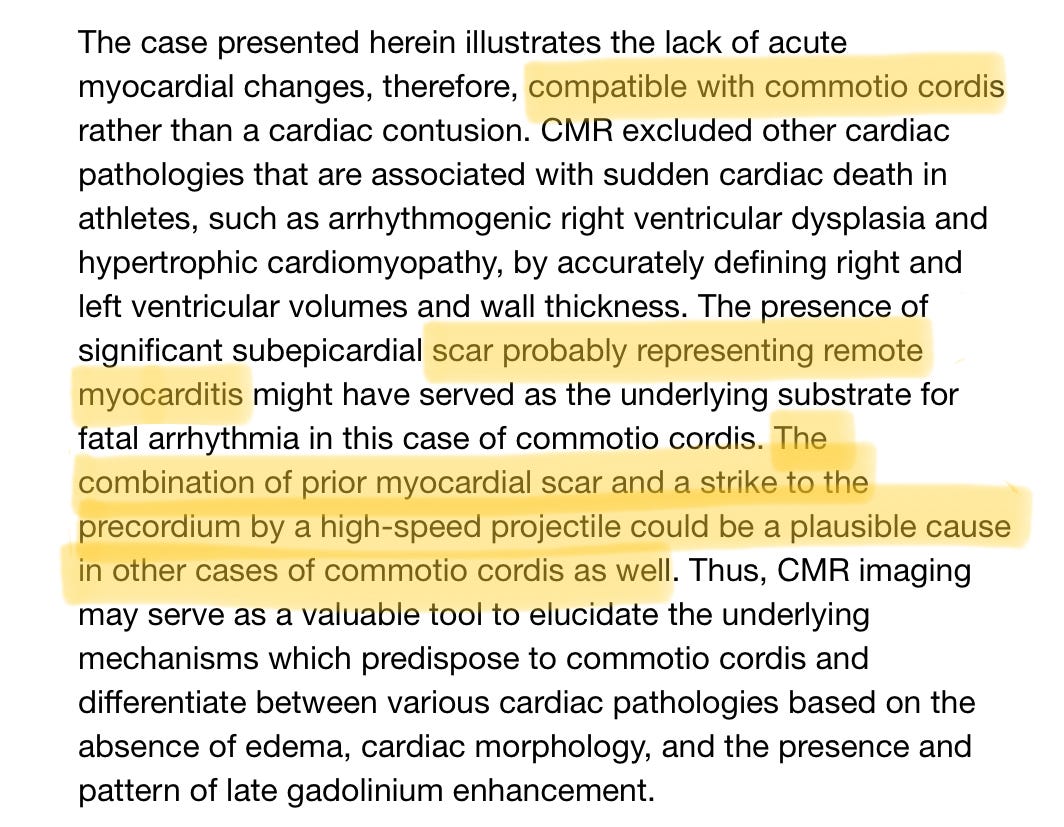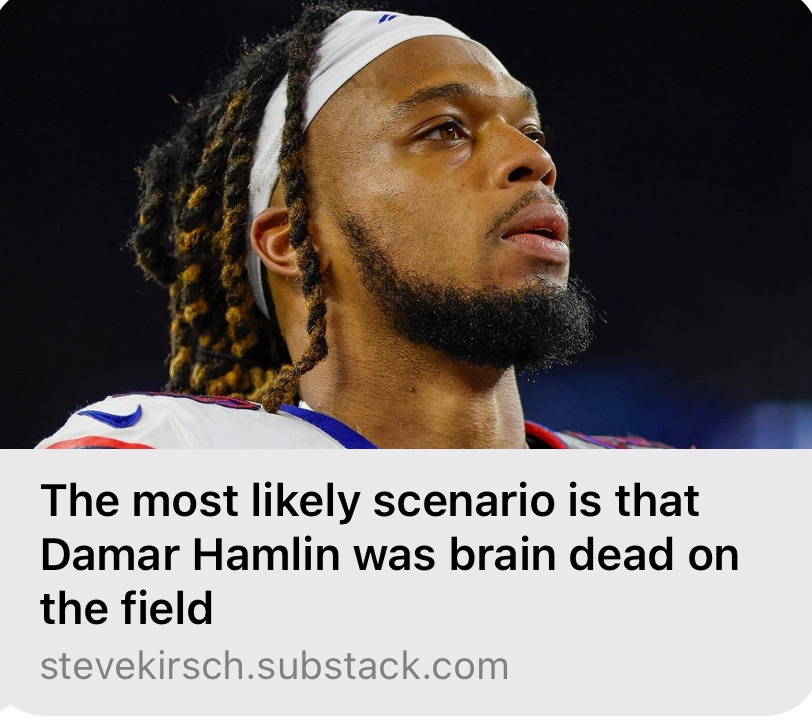Damar Hamlin's Collapse & The Inevitable mRNA Vaccine Questions
A tragic sports news story takes on a predictable second life.
I was drafted to write this piece on Damar Hamlin, despite the reasonable point of view that too many physicians have already weighed in on his personal tragedy. I’ve been too busy tending to my own medical needs these past two months to maintain my weekly writing schedule; an out-of-the-blue throat cancer diagnosis has necessitated some detours from my usual way of being. (Those curious about my experience are welcome to migrate over to my other Substack, since I am, of course, writing about it.) But Damar Hamlin and his family are going through their own medical nightmare, a highly public one, and I think most of us can agree that the quality of the discourse could be elevated.
I will start with the usual caveats, which are particularly appropriate in this moment. Without direct information about what happened on that field or in the hospital, all we have are educated guesses. Medical details are few. I am not a cardiologist, and have only passing knowledge of post-arrest care and prognosis. “Humility” is the operative word here.
However, we can draw a few conclusions from what we witnessed, and it’s clear that the country has a huge appetite for knowing more about what befell Damar Hamlin. I think this is especially important to do now, with conspiratorial whispers rising to shouts that the mRNA vaccines should be held responsible for his cardiac event. We might even be able to hold different possibilities in mind without concluding that only one explanation can be true.
The first explanation that began to circulate widely late Monday night, after Hamlin had collapsed to the field after making a rather mundane tackle, was that the hit he absorbed from Bengals receiver Tee Higgins’ shoulder and helmet to his chest had triggered a rare sports injury known as “commotio cordis.” We doctors do a lot of pattern recognition, and when you see a young athlete take a blow to the chest and then collapse in short order, commotio cordis is the pattern that knowledgeable cardiologists immediately recognized.
However, some were more circumspect:
And others ran in the opposite direction, for the very good reason that since commotio cordis implies a purely accidental injury to a healthy heart, then this tragedy couldn’t have been caused by you-know-what:
Now, Dr Peter McCollough is a big-time cardiologist, and until a few years ago his words carried a great deal of weight in the medical community. He has since shifted to a virulently anti-mRNA-vaccine posture, one which to my eyes long ago left the station of caring about actual facts or their accurate representation. Of course, when a prominent cardiologist like Dr McCollough casts aspersions on the conventional wisdom’s diagnosis of commotio cordis, the many millions of anti-mRNA-vaccine folks in this country prick up their ears. Suddenly, we have an actual ideological feud underway over why an innocent football player’s heart stopped — a sadly American phenomenon these days.
What really happened? We might never know. We only have clues at this point.
I am a great believer in Occam’s razor, the ancient “principle of parsimony,” that the simplest explanation for a natural phenomenon is to be preferred. Nothing I learned in medical school guides me as often in trying to diagnose my patients. In the case of Damar Hamlin, the only thing we know is that he was hit in the chest, and then he suffered a ventricular arrhythmia which could be explained by being hit in the chest. Occam says: commotio cordis; why invent a possible backstory?
However, what I did learn in med school was that when you hear hoofbeats, think of horses, not zebras. In other words: common things are more likely to present in uncommon ways than classic presentations of rare diseases. What’s common in football is sudden cardiac arrest from a pre-existing, often unknown, problem with the heart. Here is the break-down based on 64 autopsies of NCAA athletes who died of cardiac arrest while playing sports (I will note that this study was met with some surprise as 25% of deaths were associated with a structurally normal heart, more so than what is usually considered the most common trigger for sudden cardiac death, hypertrophic cardiomyopathy):
Note the tiny sliver reserved for commotio cordis, and the rather larger one for myocarditis, which could theoretically induce a fatal arrhythmia either in its acute phase or later, due to the presence of scar tissue (the heart being a remarkable organ in which its muscle cells also function as nerve conductors, hence the risk of arrhythmias when scar tissue occurs due to events like heart attacks or myocarditis).
The only people with insight into which slice of that pie most likely describes Damar Hamlin’s heart are his hospital physicians, who presumably performed an echocardiogram of his heart as soon he was stable enough to allow one. Those conspiratorialists concerned that they saw scar tissue consistent with, say, an old post-vaccine myocarditis — but will deny it! — should probably hear now that even they may have no idea. I rather expect that after the sort of injury his heart absorbed from not having circulating blood to support it for many minutes — after all, the heart muscle requires blood from its coronary arteries just as much as every other organ needs a blood supply — it might be very hard to differentiate a small older injury or a newish area of inflammation (i.e., acute myocarditis) from all the new damage. Perhaps a cardiac MRI would give some information in this regard, perhaps not, but this will not be done until Mr Hamlin is completely stable, in any case.
I think, though, barring any real zebras, these are our most likely scenarios:
1) The conventional wisdom is correct, and despite Mr Hamlin being somewhat older, and the impact rather less focused than the typical baseball or hockey puck trigger for commotion cordis, indeed he had a healthy heart and had the incredible misfortune to be the first NFL player (and among only a dozen known cases recorded at any level of football) to suffer from this rare trigger of a fatal heart arrhythmia. I initially found this the most likely explanation after reading the perspectives of many cardiologists. Despite a number of objections by the likes of Dr. McCullough, there really was nothing about what we saw happen on Monday night to rule out commotio cordis, as detailed in this article; and sometimes the most obvious explanation is the correct one.
OR
2) The chest impact was a mere coincidence, and it was the adrenalin surge from a difficult tackle in a huge game that tipped off some latent problem in Damar Hamlin’s heart. This could include genetic abnormalities in conduction or an enlarged heart, either of which should have been picked up at a 90+% rate from the EKG I understand all players in the NFL Combine undergo; but that leaves a small chance it could have been pre-existing but missed. It could also include damage to the heart in the form of myocarditis from a recent mRNA booster shot, but there is no evidence that Mr. Hamlin actually received a recent booster, and no NFL policy in place to require an updated booster. On the other hand, it could also include damage to the heart from a viral infection, which seems rather more likely than the booster theory, since it was reported in late November that 5 Bills players including Hamlin missed practice with an undisclosed illness. While I think cardiac arrest sans commotio cordis is a possibility, I don’t think it likely; and every possible explanation within that realm is bit less likely itself. Occam would not care for downgrading that blow to the chest as a mere coincidence.
OR
3) Damar Hamlin had a pre-existing heart condition, as per the options in #2, and the chest impact may have helped trigger the arrhythmia but it was not the sole trigger as in true commotio cordis. I did find a couple case histories in the literature of this happening, in which an athlete was diagnosed with commotio cordis only to be found later to have an underlying heart abnormality that resurfaced. In this case report of a 35-year-old soccer player who collapsed after being hit in the chest by a soccer ball — again, in the context of commotio cordis, an older-than-typical athlete, struck by an atypical blow — the authors hypothesize that indeed prior myocarditis might have triggered his apparent heart event:
Honestly, option #3 was my leaning after a little time to digest — it seemed too strange to believe that the blow to the chest was a mere coincidence, but also implausible that we should be seeing the first ever occurrence of true commotio cordis in the NFL. My Inner Occam was perplexed; hence the motivated additional research. I’m unconvinced, though. As this study details, research from the 1980-2006 time period revealed that, while sudden death due to heart disease runs at about a 25:1 clip over commotio cordis in football players (compared to only 2:1 in baseball players), there were 12 recorded cases among football players — it’s not an unprecedented event.
This Big Think piece contextualizes those cases nicely; there are over a million high schoolers playing football every year, and barely 2000 NFL-level athletes. Of course, rare events are less likely to accrue in the elite wedge of NFL players compared to the 500-fold greater number of young players; that “never before in the NFL” and “rare in older athletes” argument might be more a function of statistics than style of play and body habitus.
However, it’s worth one more look at those 12 cases of commotio cordis in 26 years of reporting. Of course, there is inevitable misclassification and undercounting in any reporting of this sort. Still, that tiny number does stand out, especially when you consider that Pop Warner adds another third of a million participants into the mix, and college over 50,000. If 1.5 million athletes are playing football every year, and only accumulate 12 cases of commotio cordis over a 26 year span, this is not a “one-in-a-million” shot, it is more like 1 in 3 million, per athlete, per year, leading to a cardiac arrest attributed to commotio cordis. We might expect 1500 years between commotio cordis events at that clip in the NFL. Cardiac arrest not related to commotio cordis, at 25X the rate: every 60 years or so. The last time the NFL witnessed a sudden cardiac death? 51 years ago, in 1971, when Chuck Hughes collapsed a few plays after a hit, and died of an apparent massive heart attack due to underlying unstable heart disease.
Occam would scratch his monastic whiskers over this problem.
We don’t need to, however.
I worked through these possibilities out of my usual curiosity, but also to make a point: those claiming this simply could not be commotio cordis out of an ideological desire to make the case that this falls in the realm of “vaccine injury” are over-stating their case. So, too, are those claiming that this is clearly commotio cordis and anyone suggesting it could be anything else, including the sequelae of an mRNA vaccine, are completely out of line. We just don’t know. We might never know.
It also does not really matter. Despite what might be inevitable discussions about adding a layer of foam/kevlar/etc into NFL player jerseys to protect their sternum, if this was really commotio cordis: it will never happen again. Proponents of adding an echocardiogram — or even cardiac MRI — to the standard Combine testing will arise; but that will add a litany of false positives threatening player’s careers with the upside of preventing a death or two per century. I don’t say this to minimize those deaths, but the risks of gun use, suicide, substance abuse, and brain injury are infinitely more important to NFL players, and effective interventions in those realms would pay far higher dividends.
The only person it might matter to is Damar Hamlin himself, and his family members, to sort out if his heart was at risk before this incident. The news coming out as I write on Friday morning — that he actually spoke to his Bills teammates this morning! — is truly remarkable and heart-warming, for someone at such high risk of profound brain injury. His health risks going forward will mostly be influenced by this cataclysmic event, but he won’t leave the hospital without some information as to whether this could have been triggered by a pre-existing condition.
And that is his own business. That is where I fully part ways with those who took up his example to cast aspersions about the safety of the mRNA vaccines. There was absolutely no need to do so, and unless he or his family express concerns about this possibility and wish to publicize them, it was utterly repugnant to make this choice. Can you imagine being a family member of Damar Hamlin and being sent something like this, from Steve Kirsch’s anti-vaccine Substack?
What followed from the original article, still posted but now under a more sanguine title, was a semi-coherent attempt citing numerous unnamed “experts” and, of course, Dr Peter McCullough, to make the clear case that Hamlin was likely brain dead, and that his mRNA vaccines had caused a myocarditis which had presumably led to his death.
It’s ugly to write this sort of tripe. It’s embarrassing when utterly speculative and quickly proved to be completely incorrect. Again, though, it’s unnecessary.
If someone wishes to make the case against using the mRNA vaccines in this population, at this point in the pandemic, there is absolutely no need to display the sort of indefensible thoughtlessness of using someone in the midst of a life threatening emergency to make the point. We have more than enough quality science to this effect: the myocarditis concern in this cohort is substantial (in this JAMA article out of Canada, a commonly-reported 1/3000 clip), it might be of greater incidence via subclinical cases (a 2% rate in this well-designed study from Thailand), and Pfizer is behind schedule in releasing its Study C4591031 data on subclinical myocarditis after a booster shot in young men.
As I have written many times before, giving young, healthy men the mRNA Covid-19 vaccines is likely a cost:benefit loser due to this risk of post-vaccination myocarditis, especially since the benefit of the current boosters in those with prior infection or at low risk of severe disease appears to be ephemeral and limited. Mandating them is inexcusable for this reason. The NFL has not mandated boosters, appropriately; those few educational institutions still insisting on required boosters for their students this past year have received appropriate heat.
The anecdotes gained from tragedies of athletes collapsing on the pitch are just that: tragic anecdotes. They need to be carefully curated to have any statistical value. To my eyes, that has not been accomplished.
Whatever led to Damar Hamlin’s collapse on Monday Night Football has no bearing on the science in play. We might disagree as to the role his presumed earlier vaccinations might have played in his cardiac arrest, but we should all agree to respect his and his family’s wishes before using him as a tool in a bitter argument. Damar Hamlin deserves better.











If you hear hoofbeats, expect horses. What we have is a whole herd of myocarditis thanks to the mRNA shots being mandated. It's appropriate to have this now-common condition at the top of the differential.
Commotio Cordis (CC) is a diagnosis of exclusion. Before making the diagnosis all other diagnosis must be excluded! When an expert jumps to that diagnosis first they are no expert. Given the high correlation between mRNA vaccines and myocarditis in young males and the high prevalence of mRNA vaccines: CC is the zebra. The diagnosis really will require a multitude of different imaging, enzymatic, and antigen antibody testing to make a diagnosis. It is more than likely that almost all cases of CC represent a failure to diagnose the underlying pathology. As new tests are developed the incidence of true CC will certainly decrease.
Mr. Hamlin’s short term recovery will be determined by how much cerebral perfusion remained during the arrhythmia and how long until the hypoxia was reversed. Hats off to the CPR team and
prayers for Mr. Hamlin!!